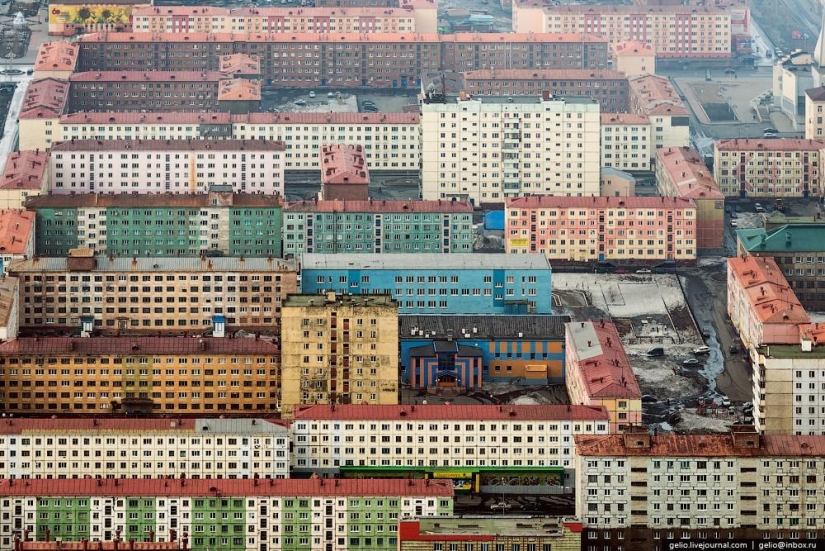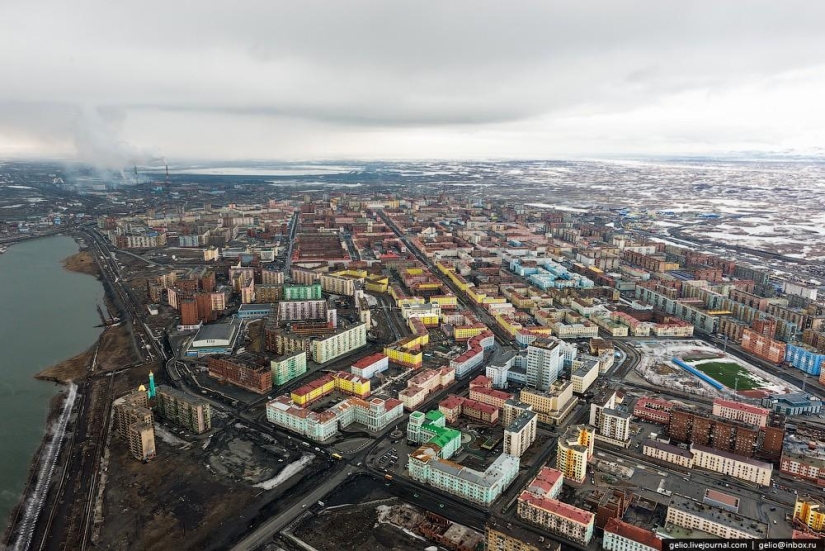Norilsk and Dudinka from above
Blogger gelio writes: “In early June, I again visited Norilsk, one of the largest cities located beyond the Arctic Circle. It is surprising that in June it is still snowing here and even there are snowdrifts as high as human height. Another feature is the polar day - this is when the sun goes in a circle without going beyond the horizon. This report contains photos taken during a helicopter flight from Norilsk to Dudinka. You can appreciate the uniqueness and severity of these places for yourself.”
(Total 28 photos)


1. Norilsk is a city in the north of the Krasnoyarsk Territory, 90 km east of the Yenisei.

2. It owes its appearance to the construction of the world's largest mining and metal-producing plant.
3. Norilsk is the second largest city in the world in terms of population, located beyond the Arctic Circle, after Murmansk.
In total, more than 170 thousand people live in the Norilsk industrial region. It is surprising that, despite the harsh climate, not “shift workers” live here, but entire generations of families who are not going to leave anywhere. And the climate here is really harsh - the temperature in winter reaches -50 ° C.
4. There are polar days and polar nights in the city. The polar day lasts about 2 months (the sun goes around in circles without touching the horizon), and the polar night lasts about 1.5 months (the streets are completely dark and the lights do not turn off).
5. The front entrance to the city is Norilsk's "visiting card".
6. The architecture of Norilsk was formed under the influence of two main factors: firstly, the peculiarities of the construction of buildings on permafrost soils and, secondly, the existing standard projects.
7. Time has shown that almost the entire part of the "old city" and the buildings of "Stalinist architecture" have become uninhabitable. This led to a rethinking of construction on permafrost. In particular, the destruction of buildings took place in Norilsk due to the collapse of housing and communal services in the 1990s.
8. The districts of the city are clearly divided according to the time of construction.
9. Leninsky Prospekt - the central street of Norilsk. It passes through almost the entire central district of the city - from Oktyabrskaya Square to Metallurgists Square.
10. October Square.
In the architecture of many buildings in Norilsk, there is a stylistic similarity with the architecture of Leningrad / Petersburg - this is due to the fact that Leningrad architects participated in the construction of Norilsk.
11. Krasnoyarskaya street.
12. Hotel "Norilsk".
13. Neighborhood No. 10.
14. Trade and sports and entertainment complex "Arena-Norilsk".
15. Lake Dolgoe, used as a cooling basin for the Norilsk thermal power plant.
16. Norilsk Polar Drama Theater named after Vladimir Mayakovsky.
17. Bus station.
18. Mount Schmidt.
19. Nickel plant in the "old town".
Enterprises of the Norilsk Combine carry out toxic emissions into the atmosphere in large quantities, as a result of which the ecological situation in the city is catastrophic.
20. Kayerkan.
District of Norilsk, which had the status of a city from 1982 to 2005, located 20 km from Norilsk. It was formed thanks to the coal deposit discovered here.
21. The further development of the village of Kayerkan was associated with the construction and start of operation of the Nadezhda metallurgical plant.
22. Nadezhda Metallurgical Plant. B.I. Kolesnikov.
23. Located on the Nadezhda Plateau on the site of the former airport, 12 km from Norilsk.
24. The plant processes the entire volume of nickel and pyrrhotite concentrates from the Talnakh concentrator, part of the nickel concentrate from the Norilsk concentrator, and the entire volume of copper concentrate from the Nickel Plant.
25. The composition of the NMZ includes three industries - hydrometallurgical (HMP), pyrometallurgical (PMP) and oxygen production.
26. Spray pools.
27. Used for surface cooling of melting units.
28. The finished products of the plant are matte, copper anodes and elemental sulfur.
29. Feinstein is sent for further processing to the Nickel Plant and the Severonickel Combine, anode copper to the Copper Plant.
30. Copper plant.
Processes the entire volume of copper concentrates from the Norilsk and Talnakh enrichment plants and copper anodes from the Nadezhda Metallurgical Plant.
31. The plant produces approximately 300 thousand tons of electrolytic copper per year. In addition, the finished products of the Copper Plant are sulfuric acid and sulfur.
32. The evicted village of Alykel is a former military pilots' village. After the withdrawal of the squadron, he became uninhabited.
33. Residential formation Oganer.
34. Norilsk CHPP-1.
35. Bridge across the Norilsk River connecting Norilsk and Talnakh by road and rail.
36. Oktyabrsky and Taimyrsky mines near Talnakh.
37. Airport of local airlines "Valek".
38. Dachas (although in fact these are camp sites, and real Norilsk dachas look like this).
Winter in these parts lasts 268 days a year!
39. Tundra.
40. Dudinka.
A seaport in the lower reaches of the Yenisei, with which Norilsk is connected by road and rail (there is no overland communication with other cities of the Russian Federation). It is the northernmost international seaport in Russia and the largest in Siberia.
41. Dudinka is the only port in the world that is annually flooded during the spring ice drift.
42. The main regional transport hub, which ensures the vital activity of the entire district and the Norilsk industrial region, the products of the Polar Division of OJSC MMC Norilsk Nickel are exported through the port.
43. The capacity of the port's berths is 25 thousand tons per day. The annual cargo turnover of the port is about 3 million tons.
44. The berths of the port are flooded during the spring flood, in connection with this, there is a complete evacuation of equipment and cargo to an unflooded mark of 20 m.
45. Loading containers at the "zero" berth.
46. Summer navigation is 130 days, from June to October. Winter navigation is provided by escort of transport vessels by the icebreaking fleet.
47. Vessels and barges in the roadstead.
48. Barge with containers and cars.
49. Here it is - June in the north.
Keywords: Polar region | Norilsk | From above
